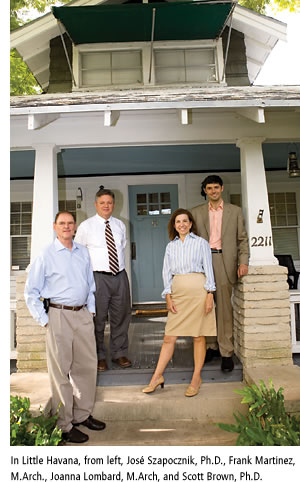Architecture and Health
UM Researchers Find Hispanic Elders Benefit from ‘Eyes on the Street’
 A unique partnership between the Miller School’s Center for Family Studies and the UM School of Architecture is deepening the existing research on what makes communities “walkable”—and how walkable communities contribute to the health, safety, and well-being of the people who live in them.
A unique partnership between the Miller School’s Center for Family Studies and the UM School of Architecture is deepening the existing research on what makes communities “walkable”—and how walkable communities contribute to the health, safety, and well-being of the people who live in them.
Before communities were designed to accommodate cars, architectural features like front porches, windows, and stoops positioned close to the sidewalk were ubiquitous in urban architecture. A new study reinforces the theory that these urban codes—which were supplanted after World War II by suburban codes calling for flat-faced homes pushed back from the curb—enhanced social support and reduced crime in neighborhoods.
Architectural features that increase the ability of passersby to make eye contact with residents are referred to by researchers as “eyes on the street,” a term coined by social anthropologist Jane Jacobs in 1961.
The latest study produced from the UM collaboration reveals that the prevalence of “eyes on the street” results in better physical functioning for Hispanic elders living in Miami’s East Little Havana neighborhood. The findings appear in the October issue of the journal Environmental Health Perspectives and are available on the journal’s Web site: www.ehponline.org.
“In this study we’re looking at how to grow communities in which elders can remain and preserve their good physical functioning,” says José Szapocznik, Ph.D., director of the Center for Family Studies and chair of the Department of Epidemiology and Public Health, who led the study at the center with research assistant professor Scott Brown, Ph.D., and Joanna Lombard, M.Arch., from the School of Architecture.
“If communities protect the elders’ functioning, the elders will be able to stay in their homes for a much longer period of time,” Szapocznik says. “This has implications on a humanitarian level for the elder and on an economic level for society.”
Supported by grants from the Robert Wood Johnson Foundation, the National Institute of Mental Health, the National Institute of Environmental Health Sciences, and the National Institute on Aging, the UM researchers measured architectural features for all 3,857 lots in the 403-block area of East Little Havana, then randomly selected one elder per block to answer questions about their level of social support.
Two years later, the elders completed measures of physical functioning including hand strength and walking speed.
The investigators found that elders who lived on blocks with few positive front-entrance features were 2.7 times as likely to have subsequent poor physical functioning compared to elders who lived on blocks with a greater number of positive front-entrance qualities.
“To our knowledge, this is the first study to show a relationship between block-level architectural features and residents’ health,” says Brown, lead author of the study.
The group is now using the same data to determine where elders walk, which will help them ascertain what aspects of the built environment promote or discourage physical activity among elders.
The research team believes that new zoning policies established now will lead to changes in how our communities are built years down the road.
“If we look at other areas where we’ve made big policy changes as a society, like with smoking and diet, we see that those changes started with research,” says Szapocznik.